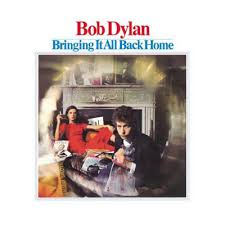Bringing It All Back Home
| Bob DylanBringing It All Back Home
Bringing It All Back Home is the fifth studio album by American singer-songwriter Bob Dylan, released on March 22, 1965 by Columbia Records. The album is divided into an electric and an acoustic side, although the acoustic side included some tracks in which other instruments were backing up Dylan and his guitar, but no drums were used. On side one of the original LP, Dylan is backed by an electric rock and roll band a move that further alienated him from some of his former peers in the folk music community. Likewise, on the acoustic second side of the album, he distanced himself from the protest songs with which he had become closely identified (such as "Blowin' in the Wind" and "A Hard Rain's a-Gonna Fall"), as his lyrics continued their trend towards the abstract and personal.-Wikipedia
Critic Reviews
Show All-
 Rolling Stone
Rolling Stone
March 22, 2016. Dylan went electric, invented folk rock and redefined what can be said in a song.
-
 Soundblab
Soundblab
July 28, 2017. While there are any number of Bob Dylan records that could easily qualify as a ‘classic’ album, Bringing It All Back Home (or Subterranean Homesick Blues as it would be known across Europe) is perhaps Dylan’s finest hour; the record is the very definition of a ‘must listen’; the sound of an artist coming into his own.
-
 Sputnik Music
Sputnik Music
January 19, 2006. The song structures are simplistic, and his lyrics are sardonic, but his voice and emotions further the satirical state of the album. His lyrical structures rhyme quite often and he has this nasal honk in his voice that is just a sonic hyperbole for freedom of speech.
-
 Pop Matters
Pop Matters
March 16, 2012. Yes, he's in the process of fully separating himself from the dogma of the folk movement—and he had already dissociated himself from the protest sounds by the time of Another Side of Bob Dylan in 1964—and the result is a songwriter who has found an entirely new footing, leaving his contemporaries in the dust.
-
 All Music
All Music
This is the point where Dylan eclipses any conventional sense of folk and rewrites the rules of rock, making it safe for personal expression and poetry, not only making words mean as much as the music, but making the music an extension of the words. A truly remarkable album.
-
 Ultimate Classic Rock
Ultimate Classic Rock
March 22, 2016. Bringing It All Back Home was a pivotal album for Bob Dylan. It's the record where he made his tentative steps toward rock, while not fully abandoning the topical songwriting on which he made his name. In the process, the nation's best young protest singer became one of rock's toughest and most uncompromising artists.
-
 The Wall Street Journal
The Wall Street Journal
March 18, 2015. Bob Dylan’s “Bringing It All Back Home,” 50 years old on Sunday, has as strong a claim as any album of its day to be called the spark that ignited the music of the 1960s.
-
 itunes Apple Music Preview
itunes Apple Music Preview
You can tell Bob Dylan knew he’d found greatness by blending folk and rock ’n’ roll.
-
 MoFi
MoFi
. . . Bob Dylan's Bringing It All Back Home represents the moment that pop and rock music became their own art form, expressions finally treated with the same seriousness and respect as classical and jazz.
-
 The Best of Website
The Best of Website
Overall, Bringing It All Back Home is a classic album. Besides a few average songs in the middle of the disc, everything else is vintage.
-
 Countdown Kid
Countdown Kid
May 22, 2013. His 1965 album Bringing It All Back Home was the first of many 180-degree turn he made in his career as he shifted into electric-based blues music and trippy surrealistic lyrics and came out with a stunning triumph.
-
 PPcorn
PPcorn
2015. Any artist could release an album this important and be done for a couple of years and nobody would complain. There’s so much in here to absorb. But of course, this is Dylan we’re talking about, and contrary to the last lines of the last song on this album, it’s actually not “all over now, Baby Blue.” Not by a long shot.
-
 Norman Records
Norman Records
1965’s Bringing It All Back Home is neatly split between a ‘rock’ electric side and a ‘folk’ acoustic side, and includes essentials like ‘Subterranean Homesick Blues’ and ‘Mr Tambourine Man’.
-
 Getintothis
Getintothis
March 27, 2015. Instead of another bash-you-over-the-head protest anthem in the grand folk tradition, the new album’s first side sees the then 23-year old Bob backed by an electric rock band, earning the wrath of the traditionalists, exacerbated by the classic Like A Rolling Stone single four months afterwards and his controversial electric Newport Folk Festival appearance later that same month.
-
 TV Tropes
TV Tropes
Bringing It All Back Home is the fifth studio album by Bob Dylan, released in 1965. It is generally seen as one of his best works and an important New Sound Album in his catalogue due to Dylan's use of electric guitar which upset Folk Music purists.
-
 The Night Owl
The Night Owl
2001. Recorded in three short days in January 1965, Dylan broke all musical boundaries with this album, producing a remarkable collection of songs unlike anything else up to that time.
-
 Keno's Classic Rock n Roll Web Site
Keno's Classic Rock n Roll Web Site
2003. Overall when you listen to old Dylan albums from the '60s you got to remember the times and how they were a-changin', if you do, you'll love the lyrics and what your hearing that much more.
-
 Pitchfork
Pitchfork
September 21, 2010. The 1965 album Bringing It All Back Home comes from Bob Dylan's transition period, the moment where he was split between the acoustic Greenwich Village folk music of his early records and the divisive electric-guitar folk-rock stuff he'd embrace more fully on Highway 61 Revisited later that year.
-
 Turntable Lab
Turntable Lab
2017. Bringing It All Back Home was originally recorded in 1965 and is considered by many to be one of the greatest albums in rock history.
-
 Best Classic Bands
Best Classic Bands
Unlike Dylan’s previous efforts that he had performed solo, Bringing It All Back Home had the singer-songwriter backed by a band.
-
 Analog Planet
Analog Planet
January 22, 2013. One side electric, one side acoustic, both sides of this March, 1965 release announced in both words and music Dylan's liberation from his folk music and "spokesperson for a generation" straight jacket and a turn towards more personal expression.
-
 Reddit
Reddit
2017. But in 1965, Dylan shocked the world and offended his fans by going electric on Bringing It All Back Home. At the time, his fans reviled him for what they saw as a betrayal, but this album has been proven by history to be one of his best in a career that has spanned six decades.
-
 Wilson & Alroy's Record Reviews
Wilson & Alroy's Record Reviews
From the first notes of "Subterranean Homesick Blues," rock and roll was changed forever. The lyrics rush by in double and triple rhymes, puns, and non sequiturs, over an insistent electric blues background:
-
 The Current
The Current
September 11, 2017. The record was divided into two sonic sides. One was — GASP! — electric, which as we all know alienated him from his peers and longtime fans. The other side was acoustic in sound, but in subject matter distancing himself from the protest songs which he had been so closely identified with.
-
 The Student Playlist
The Student Playlist
March 22, 2015. Bringing It All Back Home not only saw Dylan fuse folk with rock ‘n’ roll and change the course of music history, it was also his most complete statement to date. It’s frequently cited as one of the finest albums of all time, particularly by the traditional rock publications like Rolling Stone.
-
 Bible Urbaine
Bible Urbaine
April 16, 2015. The first half features more rock songs, where Dylan throws a few arrows at the traditionalists of folk music , including "Maggie's Farm" (reworked thirty years later by Rage Against the Machine ) and "Outlaw Blues". For the second half, he returns to his acoustic guitar and harmonica
-
 The Edge
The Edge
March 24, 2015. Bringing It All Back Home may principally be a pop record, but if you dig a little deeper, you can see a true genius at work.
-
 The High Fidelity Report
The High Fidelity Report
November 28, 2013. Bringing It All Back Home is a masterpiece. In the spring of 1965 Dylan was moving forward without hesitation; distancing himself from the folk community he helped redefine by going electric (Judas!).
-
 BlamoNet
BlamoNet
Brilliance. Sheer brilliance. This is the "electric" Dylan album, where funnily enough, as George Starostin says, the best songs are acoustic.
-
 Leighton Literature
Leighton Literature
July 19, 2015. it’s a record that marked the end of an era for its creator whilst simultaneously opening up paths in all directions to create an unwritten map of endless possibilities.
-
 Paste Magazine
Paste Magazine
September 12, 2012. Filled with rollicking dream-like lyricism and electrified instrumentation, 1965’s Bringing It All Back Home is an album that sees Dylan letting his imagination run wild.
-
 Don Ignacio
Don Ignacio
Half of this album is acoustic. Nonetheless, both sides represent Dylan very nearly at his peak as a songwriter and performer.
-
 Genius
Genius
2016. In ‘Bring it All Back Home’ for the first time ever and although this might not sound like a big deal it actually is, as it is widely recognised as the birth of folk rock.



Rate This Album and Leave Your Comments